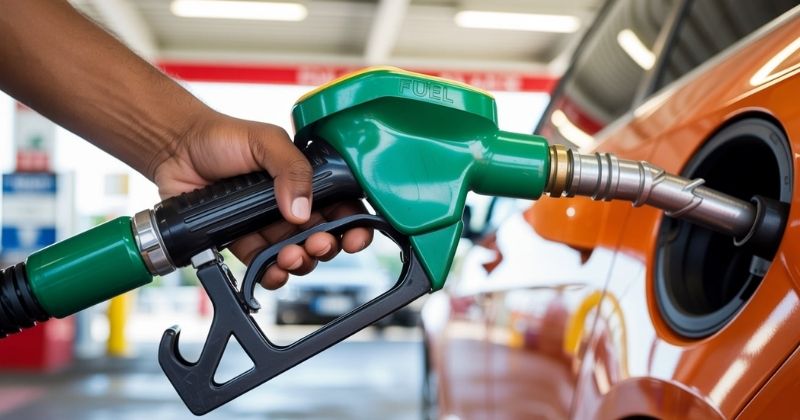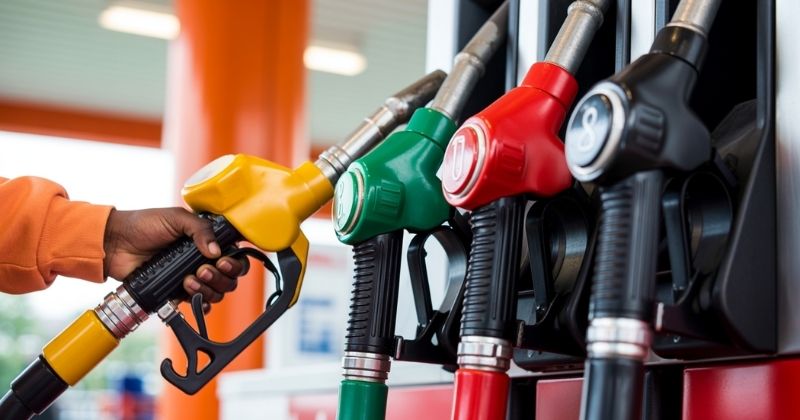
Motorists across South Africa could experience some relief at petrol stations in August, as early indicators point towards a slight decrease in petrol prices. However, this positive news does not extend to diesel drivers, who appear to be facing a potential price increase. The latest mid-month update from the Central Energy Fund (CEF) reveals a mixed performance in fuel price recoveries, with petrol showing signs of improvement, while diesel continues to underperform. This split outlook is especially significant for households and businesses reliant on diesel for transport, logistics, and backup energy needs.
Key Takeaways
- Petrol Set for Modest Decrease, Diesel Facing a Sharp Hike: Mid-month data from the Central Energy Fund shows petrol may drop by up to 24 cents per litre, while diesel is projected to increase by as much as 63 cents per litre, placing pressure on transport-reliant sectors.
- Oil Market Volatility and Global Tensions Influence Fuel Prices: Global oil prices have fluctuated due to geopolitical tensions involving Russia, the US, and the Middle East. This instability, combined with changing supply dynamics, is pushing diesel costs upward while keeping petrol more stable.
- Rand Strength Offers Some Relief but Uncertainty Remains: The rand’s relatively strong position against the US dollar has helped soften fuel price increases. However, looming US trade tariffs and unresolved international conflicts continue to add risk to South Africa’s pricing outlook.
About Arcadia Finance
Apply for a loan easily with Arcadia Finance. Choose from 19 trusted lenders, all registered with South Africa’s National Credit Regulator. There are no application fees, and the process is fast, secure, and tailored to your needs.
Latest CEF Snapshot Reflects a Split in Fuel Performance
According to the CEF’s mid-month snapshot, petrol prices are currently experiencing an over-recovery, whereas diesel prices are showing a significant under-recovery. This disparity in fuel pricing is largely driven by recent instability in global oil markets, which have fluctuated heavily in recent weeks. Despite this global uncertainty, the rand has managed to hold its ground against the US dollar, which has partially offset the negative impact for local fuel consumers.
The most recent figures from the CEF indicate that petrol is over-recovering by between 20 and 24 cents per litre. In contrast, diesel is under-recovering by roughly 62 cents per litre.
This reversal in recovery trends could see petrol users breathing easier while diesel users brace for another squeeze on already strained transport costs.

Projected Mid-Month Adjustments
These are the provisional mid-month projections for key fuel types:
- Petrol 93: reduction of 24 cents per litre
- Petrol 95: reduction of 20 cents per litre
- Diesel 0.05% (wholesale): increase of 63 cents per litre
- Diesel 0.005% (wholesale): increase of 62 cents per litre
- Illuminating Paraffin: increase of 26 cents per litre
The CEF does not release daily projection data for liquefied petroleum gas (LP Gas), meaning price expectations for this fuel type remain unavailable at present. This gap in data creates uncertainty for households that depend on LP Gas, particularly in winter when heating and cooking needs rise.
Final Prices Will Be Confirmed Later in the Month
While the CEF’s data provides a useful indication of where fuel prices are likely to head, these figures are not definitive. The Department of Petroleum and Mineral Resources is responsible for setting the official fuel prices, which are only confirmed shortly before they are implemented. Despite this, the trends indicated by the CEF data give a reasonable forecast of upcoming changes, although market uncertainty continues to complicate precise predictions. Consumers are urged to monitor updates closely, especially those with tight fuel budgets or transport-heavy operations.

Volatile Oil Markets Shape Diesel and Petrol Trends Differently
International oil markets have undergone a turbulent period over the past month. Although there was some price stabilisation in July, risks still loom over the sector. After reaching over $80 per barrel in June, largely due to heightened tensions in the Middle East, oil prices dropped back to below $70 per barrel, following an uneasy truce in the region.
Nonetheless, international political conflicts continue to play a major role in shaping oil prices. The market saw another downturn this week amid speculation about the US government’s capacity to exert pressure on Russia concerning its involvement in the war in Ukraine, and the knock-on effect this could have on oil exports.
The US government has reportedly increased its military backing for Ukraine and floated the idea of imposing 100% tariffs on countries that do not assist in bringing the conflict to an end within a 50-day window. This move would amount to indirect sanctions against nations purchasing oil from Russia.
India has taken a prominent position among buyers of Russian crude oil, while China remains an important economic partner to Moscow and continues to import Russian oil in substantial quantities. However, there is widespread market doubt regarding whether these threatened tariffs will be enforced.
So far this year, the price of Brent crude oil has declined by approximately 8 percent, impacted by escalating trade tensions and a decision among oil-producing nations to ease supply restrictions. Market analysts currently forecast a continued oversupply, which is expected to keep oil prices below the $70 mark. This softness in oil pricing is a silver lining for petrol users, but diesel import pricing continues to climb due to divergent refining costs.
The local consequence of these developments is being seen clearly in fuel pricing trends. Diesel prices are trending upwards, placing pressure on consumers, while petrol remains on track for a moderate reduction. Transport companies, agriculture firms, and generators reliant on diesel are likely to take a financial knock if the increase holds.
Rand Holds Steady Amid Broader Dollar Recovery
Despite renewed strength in the US dollar, the South African rand has retained a relatively stable position and continues to trade below R18 to the dollar. This stability, however, is not attributed to a significant shift in South Africa’s domestic economic indicators. Instead, the recent strengthening of the rand has been largely driven by external factors, particularly the temporary weakening of the US dollar due to proposed trade sanctions.
There is speculation that the US administration may soften its approach to tariffs in favour of reaching trade agreements, a view supported by the White House’s ongoing willingness to negotiate, even as a key 1 August deadline approaches.
Improved trade terms could bolster US economic growth prospects. However, ongoing uncertainty remains around the outcome of these negotiations and the potential impact of any extended deadlines or further sanctions.
In the South African context, a 30% tariff on exports to the US is still scheduled for implementation on 1 August. Questions persist about whether the US is acting in good faith during these discussions. As a result, there remains considerable risk exposure for South Africa, especially as international markets remain cautious.
Nonetheless, the rand’s relative strength has helped to ease the under-recovery seen in diesel prices and has contributed to maintaining an over-recovery in petrol pricing. The currency’s performance has served as a crucial buffer during a month otherwise marked by external market shocks.

Expected Fuel Prices for August: Inland vs Coastal
The following are the forecasted price changes for August based on mid-month data. Diesel prices are listed as wholesale; actual pump prices may vary.
Inland Region
| Fuel Type | July Official | August Expected |
|---|---|---|
| Petrol 93 | R21.79 | R21.55 |
| Petrol 95 | R21.87 | R21.67 |
| Diesel 0.05% (wholesale) | R19.35 | R19.98 |
| Diesel 0.005% (wholesale) | R19.41 | R20.03 |
| Illuminating Paraffin | R13.15 | R13.41 |
Households using paraffin for heating and cooking should prepare for a marginal cost increase, which could strain budgets in colder regions.
Coastal Region
| Fuel Type | July Official | August Expected |
|---|---|---|
| Petrol 93 | R21.00 | R20.76 |
| Petrol 95 | R21.04 | R20.84 |
| Diesel 0.05% (wholesale) | R18.52 | R19.15 |
| Diesel 0.005% (wholesale) | R18.65 | R19.27 |
| Illuminating Paraffin | R12.14 | R12.40 |
Coastal users will see petrol drop just slightly more than inland counterparts, but diesel price hikes remain broadly consistent across both regions.
Conclusion
South African motorists are likely to face a mixed bag at the pumps in August, with petrol users benefitting from small price cuts and diesel users bracing for a sizeable increase. The local pricing trend reflects broader global pressures, from unstable oil markets to diplomatic stand-offs influencing trade and supply. While the rand has offered some cushion against international shocks, the situation remains fluid, and final prices will depend on how markets evolve in the coming weeks.
Fast, uncomplicated, and trustworthy loan comparisons
At Arcadia Finance, you can compare loan offers from multiple lenders with no obligation and free of charge. Get a clear overview of your options and choose the best deal for you.
Fill out our form today to easily compare interest rates from 19 banks and find the right loan for you.


